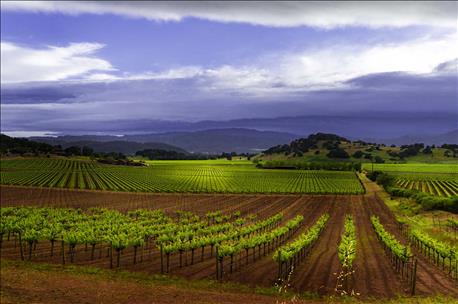
I do my farming in the Dakotas, and sometimes I’m guilty of focusing only on the type of farming that happens out our way. But of course, there’s a whole country (and world) of farming out there.
So today we’re going to focus on some of the hot farming topics in the state of California. I learned this info in a recent interview on the Cash Cow Farmer Podcast with Vaughn Brenda and Jeffrey Chapman.

The dominant crops in California are grapes and nuts. (latypova/Thinkstock)
Vaughn Brenda is the CEO and President of Valley Farms Supply, which has 4 farm supply stores in the Central Valley of California and is the parent company of the online venture Fence Post Ag. He’s also the VP of Valley Tool & Manufacturing, which produces nationally distributed brands like Vrisimo (flail mowers), Windmill Spraymasters, RockHound, and BrushHound.
Jeffrey Chapman is the eCommerce Manager of Fence Post Ag and former investment banker. They were kind enough to share some of the enormous challenges farmers in California are facing. First, let’s look at what California farmers are growing.
Dominant crops in California
Right now, the dominant crops are grapes and nuts. Mostly almonds, which are the number one nut right now, but also walnuts and pistachios.
Dairy also has a huge history in California. Those are the two arms of California agriculture: nuts and grapes, then dairy, though there are certainly others.
California’s also good in what’s called “specialty crops”: that is, crops that are not tracked on a futures market like soybeans, corn, and other major exports, but rather things like vegetables and fruits like tomatoes and strawberries. Pretty much, if it’s hard to grow, it’s grown in California.
Which makes the current obstacles in California that much harder to overcome.
The #1 challenge
There is a huge, historic drought in California, and farmers are rightfully on edge. They just went through what’s called the El Niño year, which has been a relief, but only slightly.
It’s an extremely complex issue and depending on what part of the state you’re in, your viewpoint will be different, since districts handle their water differently. Some have access to a lot of water, while others don’t, and still others are reliant on federal or other states’ water.
In short, many depend on the California aqueduct. In other parts of the state, some are more reliant on reservoir water and canal water, or “surface water,” and they might be better off. But if it doesn’t rain a lot, it doesn’t matter where you are: you’re not in a good place.
Vaughn hears stories every day about pumps going dry, and about people who are going 800-900 feet underground in search of water, which is unheard of. Research being done by really smart people is looking at how to “recharge the groundwater.”
It’s interesting because one side of the aisle says, “There’s plenty of rain. We’re just not capturing enough.” The population of California has gone up dramatically, but the number of reservoirs hasn’t.
Then people on the other side say that Californians are just using too much water. There’s a stressful divergence between the two sides.
Have farmers had to fold up shop?
Probably so, but Vaughn and Jeffrey are seeing the following scenario more commonly.
In a normal year you’ll see 80% utilization of somebody’s water, especially among farmers who have permanent crops and will do anything they can to water their crops. If you, the farmer, have hundreds or thousands of acres, you may have literally millions of dollars of investments that need water.
But if you’re planting non-permanent crops like tomatoes or melons, you can choose to fallow your fields for a time. If a field looks dry, you don’t have to plant it.
This last group has a little more flexibility, but because of the current circumstances, some of them are only farming 20% of what they could be farming. To cut your production by 60% because you don’t think there will be enough water is pretty drastic.
Farmers have to have income to buy products. How has this drought impacted the stuff sold at Fence Post Ag and Valley Farm Supply?
Vaughn and Jeffrey sell farm equipment itself, but also all the parts and supplies. When people are nervous and unsure of the future, the larger purchases tend to get shelved and purchases tend to lean more towards maintenance and trying to get one more year out of a mower or tractor.
A lot of farmers’ costs, though, are fixed. Frankly, they have land rents to pay and crops that need to be taken care of no matter what.
Their stores also tend to be closer to permanent crops vs. non-permanent crops as well.
Permanent: If you plant a vineyard, for example, you’re not replanting a vineyard every year. Or if you plant an almond orchard, it takes three, four, or five years to get your first harvest. Once you make that investment, you’re going to be farming off those crops for a long time.
Non-permanent: These are things like melons, tomatoes, and corn, which you plant at the beginning of a season and harvest at the end. Then you prepare for the next season. These people don’t have it any easier, but they do have the choice to fallow ground or take a season off.
It’s been fun to move our discussion out west and talk about what’s going on out on the west coast. Things are rough out there for our Californian brothers and sisters, but hopefully some of the creativity from various professors and manufacturers will help them pull through.
If you’re interested in any of the projects and companies that Vaughn and Jeffrey are involved in, check out these links:
The opinions of the author are not necessarily those of Farm Futures or Penton Agriculture.
About the Author(s)
You May Also Like






